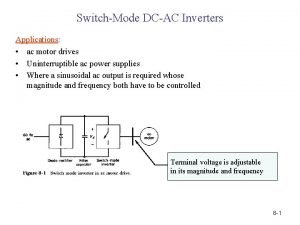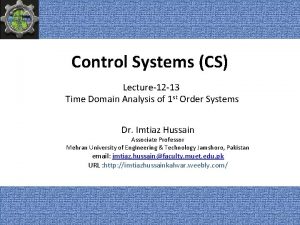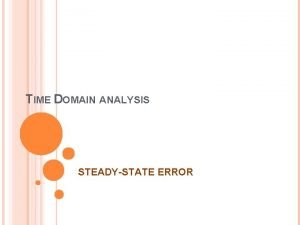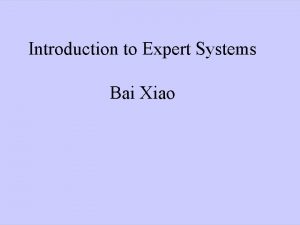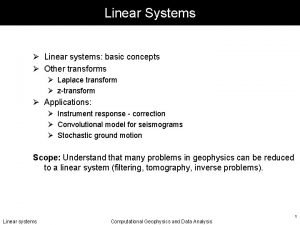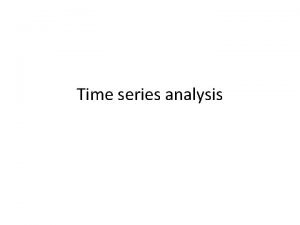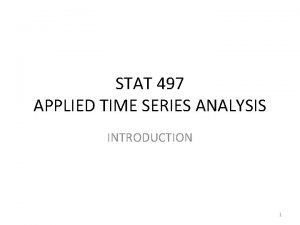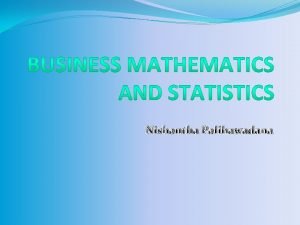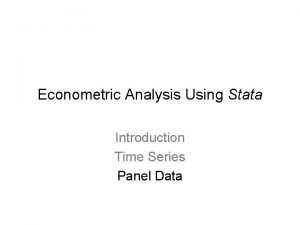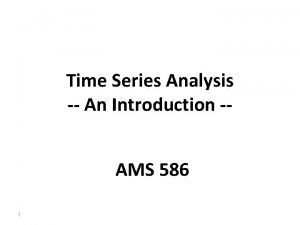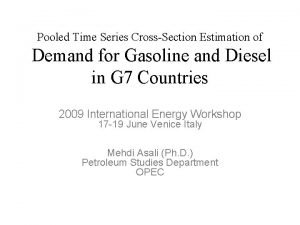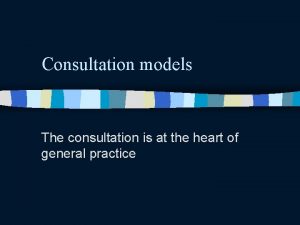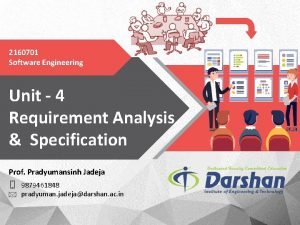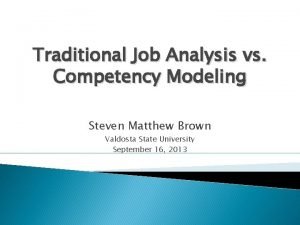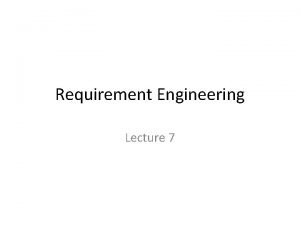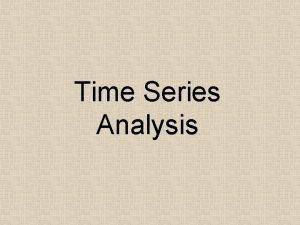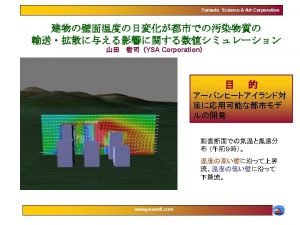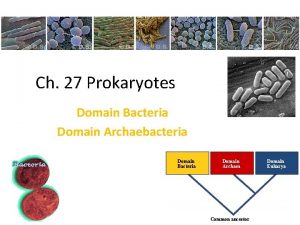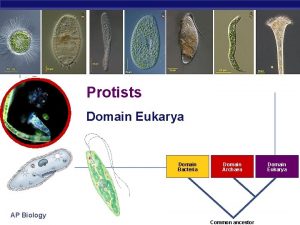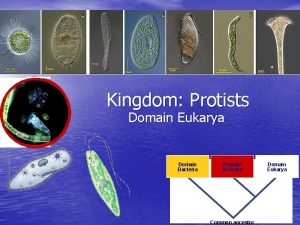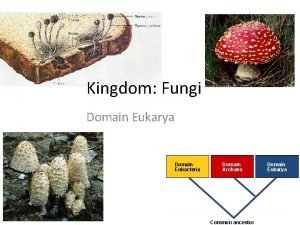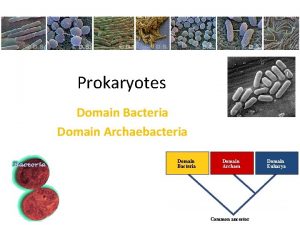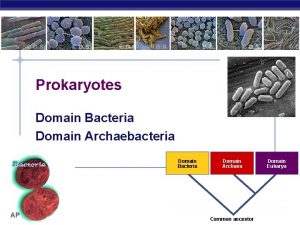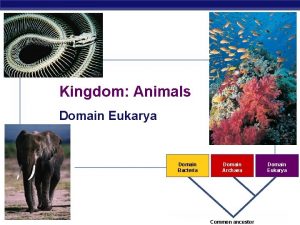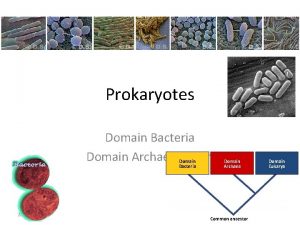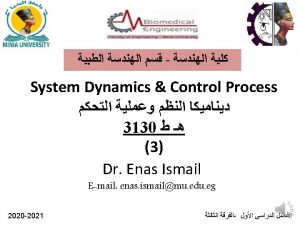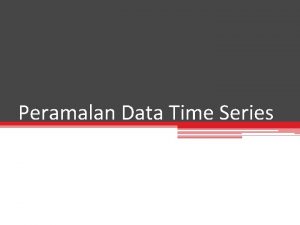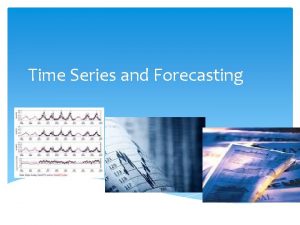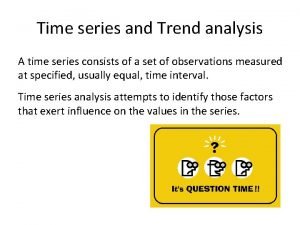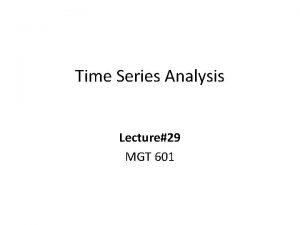LECTURE 7 TIME SERIES ANALYSIS Time Domain Models

![Recall: Statistical Model [Observed Data] = [Signal] + [Noise] “noise” has to satisfy certain Recall: Statistical Model [Observed Data] = [Signal] + [Noise] “noise” has to satisfy certain](https://slidetodoc.com/presentation_image/5faf502c238bc9a54364dec73ddf225b/image-2.jpg)









































- Slides: 43

LECTURE 7 TIME SERIES ANALYSIS Time Domain Models: Red Noise; AR and ARMA models Supplementary Readings: Wilks, chapters 8
![Recall Statistical Model Observed Data Signal Noise noise has to satisfy certain Recall: Statistical Model [Observed Data] = [Signal] + [Noise] “noise” has to satisfy certain](https://slidetodoc.com/presentation_image/5faf502c238bc9a54364dec73ddf225b/image-2.jpg)
Recall: Statistical Model [Observed Data] = [Signal] + [Noise] “noise” has to satisfy certain properties! If not, we must iterate on this process. . . We will seek a general method of specifying just such a model…

We conventionally assume Stationarity Statistics of the time series don’t change with time • Weak Stationarity (Covariance Stationarity) statistics are a function of lag k but not absolute time t • Cyclostationarity statistics are a periodic function of lag k • Strict Stationarity

Time Series Modeling All linear time series models can be written in the form: Autoregressive Moving-Average Model(“ARMA”) ARMA(K, M) MODEL Box and Jenkins (1976) We assume that e are Gaussian distributed.

Time Series Modeling All linear time series models can be written in the form: Consider Special case of simple Autoregressive AR(k) model (qm=0) Suppose k=1, and define f 1 r Special case of a Markov Process (a process for which the state of system depends on previous states) This should look familiar!

Time Series Modeling All linear time series models can be written in the form: Consider Special case of simple Autoregressive AR(k) model (qm=0) Suppose k=1, and define f 1 r Assume process is zero mean, then Lag-one correlated process or “AR(1)” process…

AR(1) Process For simplicity, we assume zero mean

AR(1) Process Let us take this series as a random forcing

AR(1) Process Blue: r=0. 4 Red: r=0. 7 Let us take this series as a random forcing

AR(1) Process What is the standard deviation of an AR(1) process?

AR(1) Process Blue: r=0. 4 Red: r=0. 7 Green: r=0. 9

AR(1) Process Random Walk (“Brownian Motion”) How might we try to turn this into a stationary time series? Suppose r=1 Not stationary Variance is infinite!

AR(1) Process Autocorrelation Function Let us define the lag-k autocorrelation: We can approximate: Let us assume the series x has been de-meaned…

AR(1) Process Autocorrelation Function Let us define the lag-k autocorrelation: Then:

Autocorrelation Function CO 2 since 1976

AR(1) Process Autocorrelation Function Recursively, we thus have for an AR(1) process, (Theoretical)

AR(1) Process Autocorrelation Function r=0. 5 N=100 “rednoise. m” “tcf. m” scf. m

AR(1) Process Autocorrelation Function r=0. 5 N=100 N=500 “rednoise. m”

AR(1) Process Autocorrelation Function r=0. 23 N=1000 Glacial Varves

AR(1) Process Autocorrelation Function r=0. 75 N=144 Northern Hem Temp

AR(1) Process Autocorrelation Function r=0. 54 N=144 Northern Hem Temp (linearly detrended)

AR(1) Process Autocorrelation Function Dec-Mar Nino 3

AR(1) Process The sampling distribution for r is given by the sampling distribution for the slope parameter in linear regression!

AR(1) Process The sampling distribution for r is given by the sampling distribution for the slope parameter in linear regression! How do we determine if r is significantly non-zero? This is just the t test!

AR(1) Process When Serial Correlation is Present, the variance of the mean must be adjusted, Variance inflation factor Recall for AR(1) series, This effects the significance of regression/correlation as we saw previously…

AR(1) Process Suppose r 1 This effects the significance of regression/correlation as we saw previously…

Now consider an AR(K) Process For simplicity, we assume zero mean Multiply this equation by xt-k’ and sum,

AR(K) Process Yule-Walker Equations Use

AR(K) Process Yule-Walker Equations Several results obtained for the AR(1) model generalize readily to the AR(K) model:

AR(K) Process Yule-Walker Equations The AR(2) model is particularly important because of the range of behavior it can describe w/ a parsimonious number of parameters The Yule-Walker equations give:

AR(2) Process Which readily gives: The AR(2) model is particularly important because of the range of behavior it can describe w/ a parsimonious number of parameters The Yule-Walker equations give:

AR(2) Process Which readily gives: For stationarity, we must have: f 2 +1 -2 -1 0 1 2 -1 f 1

AR(2) Process Which readily gives: Note that this model allows for independent lag-1 and lag-2 correlation, so that both positive correlation and negative correlation are possible. . . For stationarity, we must have: f 2 +1 -2 -1 0 1 2 -1 f 1

AR(2) Process Which readily gives: Note that this model allows for independent lag-1 and lag-2 correlation, so that both positive correlation and negative correlation are possible. . . “artwo. m” For stationarity, we must have:

AR(K) Process Selection Rules Bayesian Information Criterion Akaike Information Criterion The minima in AIC or BIC represent an ‘optimal’ tradeoff between degrees of freedom and variance explained

AR(K) Process ENSO Multivariate ENSO Index (“MEI”)

AR(1) Fit Autocorrelation Function Dec-Mar Nino 3

AR(2) Fit Autocorrelation Function Dec-Mar Nino 3 (m>2)

AR(3) Fit Autocorrelation Function Dec-Mar Nino 3 Theoretical AR(3) Fit

AR(K) Fit Autocorrelation Function Dec-Mar Nino 3 Minimum in BIC? Minimum in AIC? Favors AR(K) Fit for K=?

MA model Now, consider the case f k=0 Pure Moving Average (MA) model, represents a running mean of the past M values. Consider case where M=1…

MA(1) model Now, consider the case f k=0 Consider case where M=1…

ARMA(1, 1) model
 Time domain and frequency domain
Time domain and frequency domain 01:640:244 lecture notes - lecture 15: plat, idah, farad
01:640:244 lecture notes - lecture 15: plat, idah, farad Geology lecture series
Geology lecture series Dcac lecture series
Dcac lecture series Difference between modals and semi modals
Difference between modals and semi modals Control system
Control system Transfer function steady state error
Transfer function steady state error Domain, codomain, range
Domain, codomain, range Z domain to frequency domain
Z domain to frequency domain Roc in z transform
Roc in z transform Table of z transforms
Table of z transforms Domain specific vs domain general
Domain specific vs domain general Domain specific vs domain general
Domain specific vs domain general Problem domain vs knowledge domain
Problem domain vs knowledge domain S domain to z domain
S domain to z domain A_______ bridges the specification gap between two pls.
A_______ bridges the specification gap between two pls. Ibm p series servers
Ibm p series servers Main objective of time series analysis
Main objective of time series analysis Time series analysis
Time series analysis Time series analysis definition
Time series analysis definition Time series analysis using stata
Time series analysis using stata Importance of time series analysis
Importance of time series analysis What is the component of time series
What is the component of time series Pooled time series
Pooled time series Maclaurin series vs taylor series
Maclaurin series vs taylor series Balmer series lyman series
Balmer series lyman series Taylor vs maclaurin
Taylor vs maclaurin Maclaurin polynomial
Maclaurin polynomial Series series feedback amplifier
Series series feedback amplifier Series aiding and series opposing
Series aiding and series opposing Arithmetic sequence sum formula
Arithmetic sequence sum formula Exploratory data analysis lecture notes
Exploratory data analysis lecture notes Sensitivity analysis lecture notes
Sensitivity analysis lecture notes Factor analysis lecture notes
Factor analysis lecture notes Analysis of algorithms lecture notes
Analysis of algorithms lecture notes Streak plate
Streak plate Power system analysis lecture notes
Power system analysis lecture notes Neighbours consultation model
Neighbours consultation model Requirement model
Requirement model Airspace design analysis models sterling va
Airspace design analysis models sterling va Neighbour model of consultation
Neighbour model of consultation Traditional job analysis vs competency approach
Traditional job analysis vs competency approach Analysis models in srs
Analysis models in srs Domain analysis document
Domain analysis document



